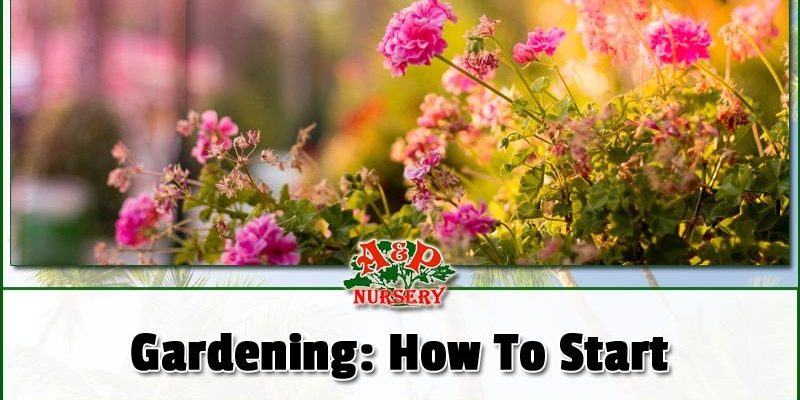The first step to start gardening is to choose the type of garden you want: flowers, herbs, or vegetables. Then choose a location in your yard.
How To Start Gardening
Landscapes are pretty plain without some color and growing your own herbs and veggies provides the freshest produce for your family.
It takes a little work, but it is possible to start gardening and enjoy seeing new flowers or having fresh herbs and vegetables.
In this post we will show you how to start gardening using simple steps.
Step 1. Decide The Type Of Gardening
The way you step up your garden, the size, and the location all are affected by the type of things you want to grow. Some plants to better in full sun while others enjoy some shade. Even if you decide you’re going to grow flowers you’ll need to decide if you want perennials or annuals. If you want to grow an herb garden you’ll need to follow the sun needs for the types you want to grow. Vegetables have similar needs to some flowers, so you might be able to choose one location and have some of both in your garden.
Step 2. Choose The Location For Your Garden
Most flower varieties and all vegetables grow better with full sun for about 6 hours a day. Take a day and watch how the sun fills your landscape to decide the best location for your new garden. Some yards won’t have a full 6 hours of sun per day. Thankfully many plants can survive and grow well even without the recommended sun light. Pay attention to plant tags as you shop for options and ensure you don’t plant something that requires more sun than you can consistently provide.
It’s best to choose a location that isn’t out of sight, as then it might be out of mind. Put it near the entrance to your home or by a window you like the view from. It’s also a good idea to choose a location that is easy to get water too with your hose.
Step 3. Clear A Spot For The Garden
If you’ve got lawn where you want your new garden you’ll have to remove it. An easy way to do it is to block the sunlight going to the lawn and let it die. This can be done with a tarp, newspapers, or cardboard. If you’re in a hurry you can manually dig your lawn out with shovels. This will leave the ground a bit uneven and you should level it out before trying to do anything else.
Step 4. Enrich Soil
For things to grow well the soil needs to be rich with minerals and nutrients. You can add compost made of old manure, grass clippings, and old leaves. Make sure you work the organic matter into the soil, especially if you dug your sod out as the ground is likely compacted. Only till your soil when the moisture level is right. If the soil is too dry or wet it can ruin it. Its best to till your soil when you can form a ball but it doesn’t stick together if you drop it. Tilling the soil and adding organic matter is a good step to do at the beginning of each gardening year.
Step 5. Choose Gardening Plants
Choose plants for your garden that either fit a need or are visually stunning to you. Make sure you’re choosing plants that will work well for your sunlight, soil, and climate. Choose veggies you love such as tomatoes, cucumbers, peppers, or lettuce. Other gardeners want to wow visitors with color and will plant annual flowers such as marigolds, snap dragons, geraniums.
Step 6. Plant Your Plants
Most plants should be planted after there is no risk of frost. In warmer areas of the world this can be done earlier or during the fall as freezing temperatures are unheard of or unlikely. For perennial flowers the fall or spring is a good time to plant them.
The way you plant each type of plant or seed will depend on the species. Read your seed packets or young plant guide to know how deep and close together you should plant them.
Step 7. Make It Rain
It’s critical to provide enough water for newly planted veggies and flowers. As they get larger you wont need to water daily. Once the roots have established you’ll have to judge how often to water based on how often it rains, the humidity, and the type of soil you have. If you see any of your plants wilting during the hottest part of the day; it’s a clear sign they need water. Water when it’s cool in the morning and allow the water to run slowly and soak in.
Step 8. Lay Down Some Mulch
Mulch is a great way to keep water in your soil and weeds out of your garden. It’s best to use a decomposing mulch for vegetable gardens and annual flowers. Whereas perennials benefit from mulch that lasts longer.
Step 9. Put In The Work
Gardening is rewarding yet it does take a commitment. Make sure you stay on top of your watering and weeding. Don’t let things get too dry or weeds so bad you don’t want to pull them. You can support more aggressive growth by using liquid fertilizer once a month and a dry fertilizer about half way through the growing season.
East Phoenix Gardening Centers
If you want to start your garden and live in the East Valley of Phoenix; A&P Nursery is here to help! We offer easy gardening kits, vegetable and flower seeds, transplant plants, fertilizer and much more. Visit one of our 4 locations in Mesa, Queen Creek, or Gilbert, Arizona.






